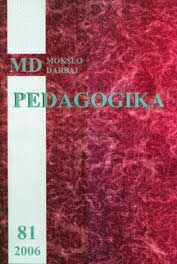Aukštojo mokslo finansavimas ir plėtra pirmojoje Lietuvos Respublikoje
The Financing And Development Of Higher Education In The First Lithuanian Republic
Author(s): Vytautas LukoševičiusSubject(s): Education
Published by: Vytauto Didžiojo Universitetas
Keywords: development; higher education; Lithuanian republic
Summary/Abstract: 1918–1940 is a very significant period in Lithuanian education and pedagogical thought. During the Russian annexation which lasted more than 100 years, all efforts were made to convert Lithuania into cultural and economic imperialistic colony. However Lithuania re-created independent republic and was able to develop its political, social and cultural life freely. After 1918, February 16th Lithuanian government started to develop educational program, though the circumstances were very complicated. The re-creation and development of higher education was one of the priorities in the first Lithuanian Republic. In 1922, February 16th, the first higher school- Lithuanian University was established in Kaunas. In 1930, observing the 400th death anniversary of Vytautas the Great, the University was given the name of Vytautas the Great. During its existence (1922–1939) the University prepared 3,5 thousand qualified specialists. In 1918–1920 more higher schools were established in Lithuania, which were fully or partly financed by the state budget. According to the significance the second important higher school was the Academy of Agriculture. It was established in Dotnuva and its inauguration took place in 1924, October 15th. This Academy was financed by the state. Later, there were more higher schools established which were financed by the state budget: Conservatoire (1933), Kaunas Art School (1935), Pedagogical Institute in Klaipėda (1935), Veterinary Academy (1936). It is interesting to mention, that there existed the only school in the world- higher Jewish rabbi school in Telšiai. In all mentioned schools in 1939–1940 studied about 4000 students and about 450 qualified teachers taught in them. The Lithuanian government supported studies financially, allotted means to build new buildings, laboratory equipment etc. From 1922 till 1940 the state allotted about 5 million Lt for establishment and development of new schools. It was not enough to support the studies (except Pedagogical Institute in Klaipėda) and students had to pay themselves. That is why to study was a privilege of rich and well-off people. Though the circumstances were difficult, the effective system of higher education was created in 1918–1940. The staff of teachers grew, the contents of teaching settled, new original textbooks and teaching means were prepared. The educational aims and tasks were assigned to develop the nation’s culture, morals and sociability.
Journal: Pedagogika
- Issue Year: 2006
- Issue No: 81
- Page Range: 7-16
- Page Count: 10
- Language: Lithuanian

